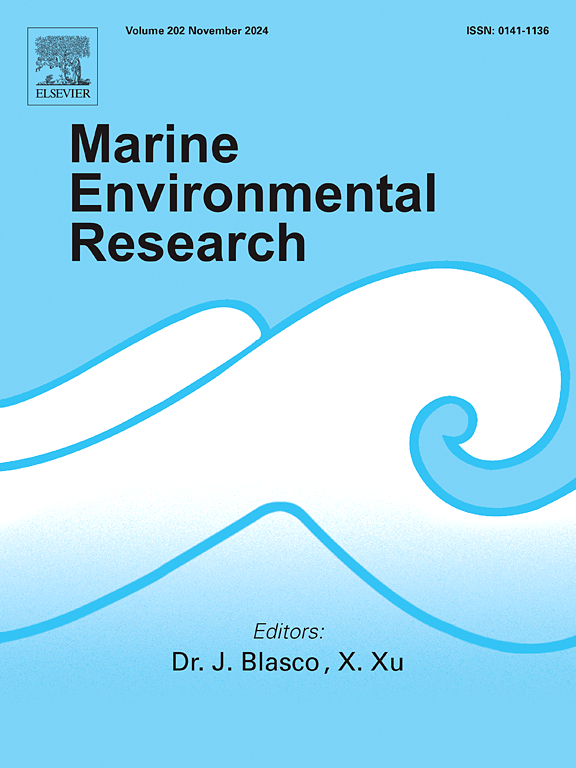Biodiversity on the move: Epibiotic communities associated with pelagic sargassum in the northeast Atlantic
IF 3
3区 环境科学与生态学
Q2 ENVIRONMENTAL SCIENCES
引用次数: 0
Abstract
Between late 2023 and early 2024, massive amounts of rafting Sargassum, made up of two co-occurring species (Sargassum natans and Sargassum fluitans; class Phaeophyceae) were recorded in the Azores and Madeira archipelagos (NE Atlantic). This phenomenon provided a rare opportunity to investigate their epibiont assemblages. Offshore algal samples were collected around São Miguel (Azores) and Madeira islands in February 2024. Sargassum fluitans III and S. natans VIII were the dominant species, supporting diverse communities of bryozoans, hydroids, crustaceans, and molluscs. A total of 15 motile and 10 sessile epibiotic species were identified. Epibiotic assemblages differed significantly in species abundance and composition between the two archipelagos, suggesting the influence of distinct local environmental conditions and ocean currents, ultimately affecting which species thrive in each location. Notably, S. fluitans III, typically the dominant morphotype linked to the Great Atlantic Sargassum Belt (GASB), was most prevalent, suggesting that the influxes in the Azores and Madeira may have originated from this region rather than the Sargasso Sea. However, the timing of sightings, the lack of known direct currents connecting GASB to both archipelagos and the proximity of the Sargasso Sea, indicate that the exact origin remains debatable. This study provides a novel geographic perspective for examining the structure and composition of epibiont communities associated with rafting Sargassum.

移动中的生物多样性:大西洋东北部与上层马尾藻相关的表层生物群落
在2023年底到2024年初之间,大量的漂流马尾藻,由两个共同发生的物种(马尾藻和马尾藻)组成;在亚速尔群岛和马德拉群岛(东北大西洋)均有记录。这种现象提供了一个难得的机会来研究它们的表观生物组合。2024年2月,科学家在米格尔岛(亚速尔群岛)和马德拉岛附近采集了近海藻类样本。马尾藻III和马尾藻VIII是优势种,支持苔藓虫、水螅类、甲壳类和软体动物的多样性群落。共鉴定出15种活动种和10种固结种。两个群岛之间的表观生物组合在物种丰度和组成上存在显著差异,这表明不同的当地环境条件和洋流的影响,最终影响了物种在每个地点的繁荣。值得注意的是,与大大西洋马尾藻带(GASB)相关的典型优势形态S. fluitans III最为普遍,这表明亚速尔群岛和马德拉群岛的流入可能起源于该地区,而不是马尾藻海。然而,观测的时间、缺乏已知的将GASB与两个群岛连接起来的直流电以及马尾藻海附近都表明,确切的起源仍然存在争议。该研究为研究与漂流马尾藻相关的表层生物群落结构和组成提供了新的地理视角。
本文章由计算机程序翻译,如有差异,请以英文原文为准。
求助全文
约1分钟内获得全文
求助全文
来源期刊

Marine environmental research
环境科学-毒理学
CiteScore
5.90
自引率
3.00%
发文量
217
审稿时长
46 days
期刊介绍:
Marine Environmental Research publishes original research papers on chemical, physical, and biological interactions in the oceans and coastal waters. The journal serves as a forum for new information on biology, chemistry, and toxicology and syntheses that advance understanding of marine environmental processes.
Submission of multidisciplinary studies is encouraged. Studies that utilize experimental approaches to clarify the roles of anthropogenic and natural causes of changes in marine ecosystems are especially welcome, as are those studies that represent new developments of a theoretical or conceptual aspect of marine science. All papers published in this journal are reviewed by qualified peers prior to acceptance and publication. Examples of topics considered to be appropriate for the journal include, but are not limited to, the following:
– The extent, persistence, and consequences of change and the recovery from such change in natural marine systems
– The biochemical, physiological, and ecological consequences of contaminants to marine organisms and ecosystems
– The biogeochemistry of naturally occurring and anthropogenic substances
– Models that describe and predict the above processes
– Monitoring studies, to the extent that their results provide new information on functional processes
– Methodological papers describing improved quantitative techniques for the marine sciences.
 求助内容:
求助内容: 应助结果提醒方式:
应助结果提醒方式:


